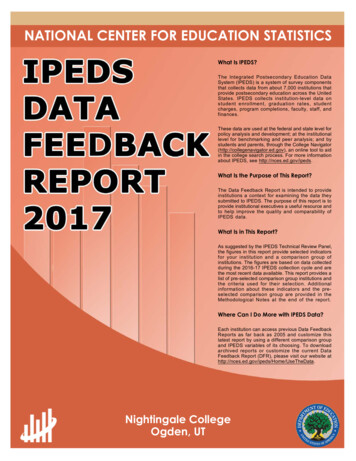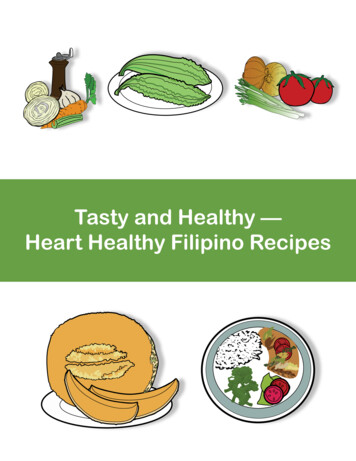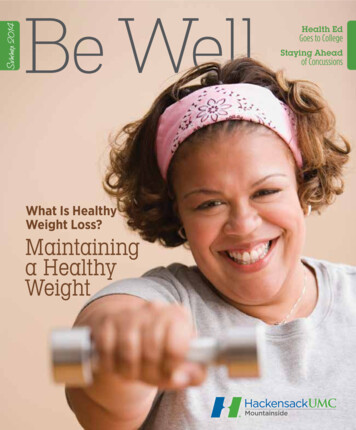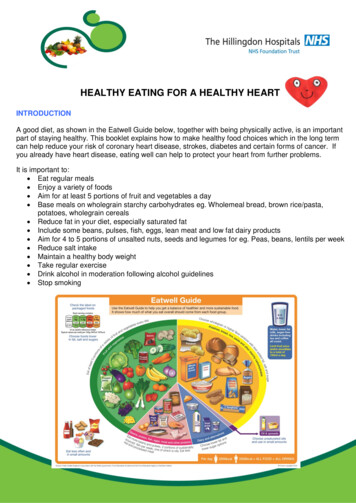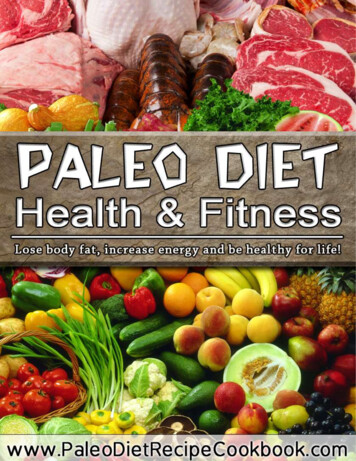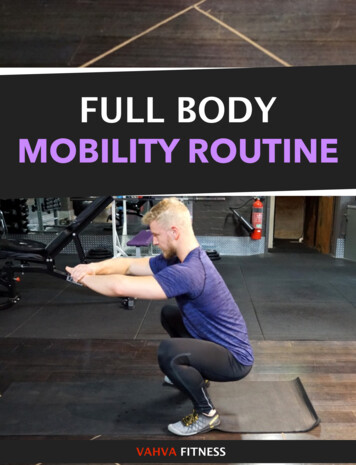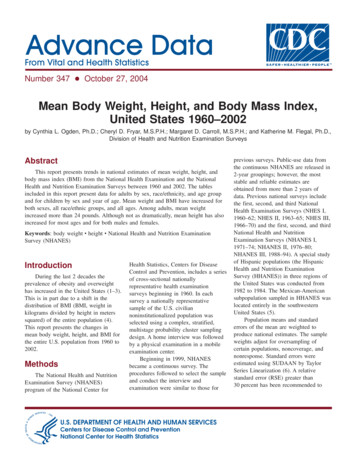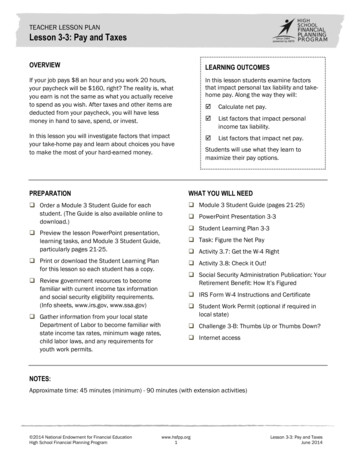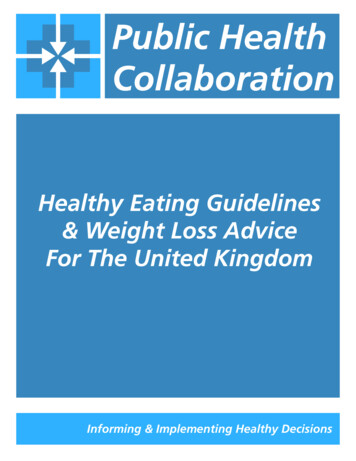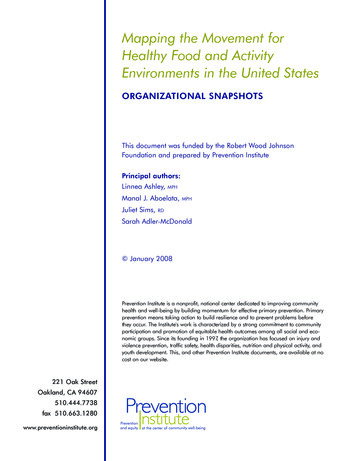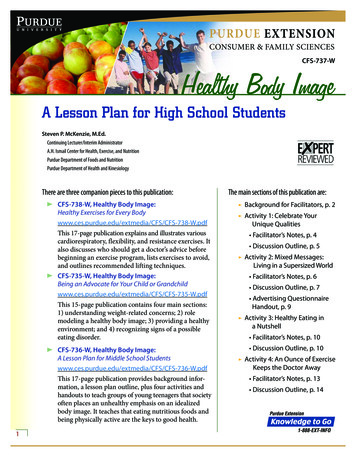
Transcription
Purdue ExtensionConsumer & Family SciencesCFS-737-WHealthy Body ImageA Lesson Plan for High School StudentsSteven P. McKenzie, M.Ed.Continuing Lecturer/Interim AdministratorA.H. Ismail Center for Health, Exercise, and NutritionPurdue Department of Foods and NutritionPurdue Department of Health and KinesiologyThere are three companion pieces to this publication:CFS-738-W, Healthy Body Image:Healthy Exercises for Every his 17-page publication explains and illustrates variouscardiorespiratory, flexibility, and resistance exercises. Italso discusses who should get a doctor’s advice beforebeginning an exercise program, lists exercises to avoid,and outlines recommended lifting techniques.CFS-735-W, Healthy Body Image:Being an Advocate for Your Child or W.pdfThis 15-page publication contains four main sections:1) understanding weight-related concerns; 2) rolemodeling a healthy body image; 3) providing a healthyenvironment; and 4) recognizing signs of a possibleeating disorder.CFS-736-W, Healthy Body Image:A Lesson Plan for Middle School pdfThis 17-page publication provides background information, a lesson plan outline, plus four activities andhandouts to teach groups of young teenagers that societyoften places an unhealthy emphasis on an idealizedbody image. It teaches that eating nutritious foods andbeing physically active are the keys to good health. The main sections of this publication are:Background for Facilitators, p. 2Activity 1: Celebrate YourUnique Qualities Facilitator’s Notes, p. 4 Discussion Outline, p. 5Activity 2: Mixed Messages:Living in a Supersized World Facilitator’s Notes, p. 6 Discussion Outline, p. 7 Advertising QuestionnaireHandout, p. 9Activity 3: Healthy Eating ina Nutshell Facilitator’s Notes, p. 10 Discussion Outline, p. 10Activity 4: An Ounce of ExerciseKeeps the Doctor Away Facilitator’s Notes, p. 13 Discussion Outline, p. 14
Healthy Body Image. . . . . . . . . . . . . . . . . . . . . . . . . . . . . . . . . . . . . . . . Lesson Plan for High School StudentsBackground for FacilitatorsThe materials in this four-activity unit on healthy body image are intended foruse with high school participants. A separate publication lists activities for middleschool participants. Activities 1 and 2 are different, based on the intended agelevel, but the rest of the materials are the same for both age groups. Each activity begins with notes for the facilitator, followed by an outline for a discussion onthat topic and, in Activity 2, a master copy of a handout. You will have to providemagazine ads for Activity 2, and you may want to provide copies of CFS-738-Wfor each participant as part of Activity 4. What follows here is some general background information about body image.Few things are more central to our long-term health and happiness than how weview ourselves. Our body image is a vitally important part of our self-image. Ourperception of our body often is influenced by how we think others view us. Manypeople feel driven to comply with their perception of how society expects them tolook. Not meeting these expectations frequently places people in a state of conflictthat results in reduced self-esteem and leads to unhealthy diet and exercise practices. The unhealthy practices commonly associated with body image issues maylead some people to become extremely underweight, while others become overweight or obese. Issues involving body image are present in all age groups and bothgenders in our society. A healthy body image should be a goal of everyone, regardless of his or her circumstances.Today, we know a great deal about how lifestyle behaviors (including good nutrition and physical activity) can help us stay healthy (ACSM, 2006, USDA, 2005a).Unfortunately, knowledge alone is not enough to motivate most people to adopta healthy lifestyle. The number of teenagers who are overweight has risen steadilyover the past two decades. In Indiana, 15 percent of teenage respondents to theYouth Risk Behavior Survey conducted by the Centers for Disease Control andPrevention were overweight in 2005, up from 11.5 percent just two years earlier(Indiana State Department of Health, 2005a).The actual number of Hoosier teens who are overweight contrasts dramaticallywith the percentages who describe themselves as overweight (the reality versusperception gap), as illustrated in Table 1.Table 1 illustrates that a significantly high number of teens view themselves asoverweight whether they actually are or not. This is especially true among females.Table 1.Actual PercentOverweightPercent DescribingThemselves as OverweightBoth ata from: ISHD, 2005a)Indiana Teens: Actual Versus Perceived Overweight 2005An even more exaggeratedcontrast between reality andperception is apparent whenwe compare the self-reporteddiet and exercise behaviorsof Hoosier teens with theiractual overweight status (seeTable 2 on next page). Purdue Extension CFS-737-W
Healthy Body Image. . . . . . . . . . . . . . . . . . . . . . . . . . . . . . . . . . . . . . . . Lesson Plan for High School StudentsTable 2.Indiana Teens and Weight Loss-Related BehaviorsBothgendersMalesFemalesActual PercentOverweightCurrently Tryingto Lose 8%20.5%30.5%51.6%27.0%9.2%63.1%73.3%57.2%(Data from: ISHD, 2005a)Table 2 illustrates that thereis clearly something otherthan being overweight that iscausing teens to be dissatisfiedwith their body and motivating them to use diet andexercise to accomplish theirperceived need for weight loss.Since many Indiana teenagers state that they are using diet and exercise to reachtheir weight loss goals, one might ask, “Are they dieting and exercising in line withcurrent national recommendations?” One key recommendation for weight management is to consume the recommended amounts of fruits and vegetables eachday (USDA, 2005b). The CDC survey asked Indiana teens whether they ate at leastfive fruit and vegetable servings per day. Eighty-four point five percent of Hoosier teens surveyed in 2005 said they did not (ISHD, 2005a). Milk consumptionis another important dietary indicator. The 2005 survey reports that 16.2 percentof Indiana teens report drinking at least the recommended three 8-ounce glassesof milk per day (ISHD, 2005a), suggesting that 83.8 percent do not. Also high onthe list of concerns about the diet practices of Hoosier teens is that 6.8 percent ofthem say that they take diet pills or use powder or liquid weight loss aids withoutconsulting a physician. Another 5.5 percent admit to vomiting or using laxativesas weight loss strategies (ISHD, 2005a). Clearly, a gap exists between what expertsconsider to be healthy and the diet and weight loss strategies actually used by Indiana teens.So what about exercise? According to the 2005 Youth Risk Behavior Survey, 60.2percent of Indiana teens report receiving an adequate amount of physical activitybased on the recommended standards of Healthy People 2010 (ISHD, 2005b). Onthe flip side, 31.9 percent of Indiana teens report watching at least three hours oftelevision per day on a typical school day, and 10.5 percent state they engage in noregular physical activity. Clearly, a significant portion of Indiana teens can benefitfrom clearly understanding the recommended quantities of healthy exercise andthe role of exercise in weight management.Teenagers in Indiana, as elsewhere, appear to feel a significant amount of pressureto conform to their perception of how society wants them to look. This pressure,whether self-imposed or external, leads many teens to participate in unhealthy dietand exercise practices. By accepting their body image and clearly understandingwhat constitutes healthy behavior (including healthy nutrition and physical activity) they can learn to lead healthier and happier lives.Selected referencesAmerican College of Sports Medicine (ACSM) (2006). ACSM’s Guidelines forExercise Testing and Prescription. Philadelphia: Lippincott, Williams and Wilkins. Purdue Extension CFS-737-W
Healthy Body Image. . . . . . . . . . . . . . . . . . . . . . . . . . . . . . . . . . . . . . . . Lesson Plan for High School StudentsIndiana State Department of Health (ISDH) (2005a). Youth Risk Behavior Survey:Nutrition and Health. ndiana State Department of Health (ISDH) (2005b). Youth Risk Behavior Survey:Physical Activity. United States Department of Agriculture (USDA) (2005a). Dietary Guidelines forAmericans. www.health.gov/DietaryGuidelinesUnited States Department of Agriculture (USDA) (2005b). MyPyramid.gov.www.mypyramid.govActivity I: CelebrateYour Unique QualitiesFacilitator’s NotesPurposeThis introductory activity is designed to help participants recognize that peopleare different in many ways, including physically. Some of these differences can bechanged by our conscious actions and efforts, while others are outside of our ability to change. Changes in our physical traits during growth and maturation (especially during puberty) are natural, inevitable, and beyond our control. We need tofocus on accepting others and ourselves and being the best that we can be, including maintaining our health.Materials needed Paper Pens or pencils Chalkboard, marker board, easel and pad, or other large writing surface ormasking tape to attach papers to the wallSuggested delivery formatThis activity is meant to be a discussion. A group discussion is suggested, but smallgroups may be used where applicable. Efforts should be made to engage as manyparticipants as possible in the discussion while being sure to cover the key points.ObjectivesBy the conclusion of today’s discussion, participants will be able to: List three ways different people are unique from each other. Be able to list three differences or similarities between the normal growthand development of boys and girls. List three things they can do that will promote acceptance and appreciationof unique qualities in others and within themselves. Purdue Extension CFS-737-W
Healthy Body Image. . . . . . . . . . . . . . . . . . . . . . . . . . . . . . . . . . . . . . . . Lesson Plan for High School StudentsDiscussion OutlineI.In what ways are people different from each other?A. List three to five ways that people are different. Write responses on theboard or paper. Possibilities are:1.2.3.4.5.6.7.8.9.Different heights.Different weights.Different body builds (slender, muscular, etc.).Different complexions.Different hair colors/types (straight, curly, etc.).Different eye colors.Different preferences.Different likes/dislikes.Different abilities (some of us are good in math, some in writing, some inart, some in sports, some in music, etc.).10.Different interests.B. Some things we can change through effort (by studying, practicing, etc.).C. Some things we can’t change, even if we want to (height, eye color, etc.).D. Some things will change naturally over time whether we want them to ornot (height and weight as we grow, preferences, interests, etc.).II. List three things that you are good at. Of these, what are you best at?A. Ask volunteers to list their No. 1 item on the board or pad.B. Discuss that everyone has his or her strengths (and weaknesses).C. A person’s strengths and weaknesses are part of what defines them as aperson (these are among their unique qualities).D. One thing that makes the world interesting is that everyone has his orher own set of unique qualities.III. Just as with other traits, each of us grows, develops, and matures atdifferent rates.A. Normal physical growth and development:1. Involves rapid changes in height, weight, and weight distribution.a. In girls:- Begins earlier than in boys.- Usually begins between 10.5 and 11.5 years (but may be as early as 8or 9 and as late as 12 or older).- Full physical growth/development is usually reached by age 15.5.- Maturation often accompanies a drop-off in physical activity. Purdue Extension CFS-737-W
Healthy Body Image. . . . . . . . . . . . . . . . . . . . . . . . . . . . . . . . . . . . . . . . Lesson Plan for High School Studentsb. In boys:- Usually begins between 11 and 13.5 years.- Full physical development is usually reached by age 16 or 17.- Is accompanied by a dramatic increase in muscle and strength.- Early physical maturity gives a great advantage in sports.2. Is often accompanied by substantial increases in appetite.B. Healthy growth and physical development depend on:1. A healthy diet that satisfies your hunger (but not dieting). The word“diet” does not always mean losing weight. It also means the usual foodand drink that a person consumes, so a “healthy diet” is just another wayof saying good nutrition.a. Normal growth and physical development require increased amountsof calories.b. Restriction of calories or nutrients during growth and maturation maylead to growth problems or even health problems later in life.2. Regular, enjoyable physical activity.C. We will be most satisfied with our growth and development if we:1. Recognize that we are all different physically (just as we are different inmany other ways).a. We each naturally have a certain body type, and that is OK.- Body type (build) is largely hereditary.- Physical fitness is a factor that is within our control.b. Our No. 1 priority should be to stay healthy.2. Recognize that change is unavoidable and is OK.3. Accept others for who they are and not how they look. This is the first stepin respect. Showing respect for others will help earn their respect for you.Take-home messageAll of us are different in many ways, both physically and in terms of ability. Someof these qualities are within our power to influence, while others are out our ofcontrol. Each of us should focus on staying healthy, being the best we can be, andshowing respect for others and their abilities. With maturity comes the capacity tothink about how our actions toward others make them feel. And as we learn tothink for ourselves, we are better able to cope with how we perceive that othersview us.Selected referenceCooper, Kenneth H. (1991). Kid Fitness: The Complete Shape-Up Program fromBirth through High School. New York: Bantam Books. Purdue Extension CFS-737-W
Healthy Body Image. . . . . . . . . . . . . . . . . . . . . . . . . . . . . . . . . . . . . . . . Lesson Plan for High School StudentsActivity 2:Mixed Messages:Living in a Supersized WorldFacilitator’s NotesPurposeThis activity is intended to raise teens’ awareness about tactics used by advertisersto sell their products and to help teens look critically at the messages these adsconvey. In magazines (and other media) frequented by teens, advertising modelsrepresent a homogeneous group of body types. Promotion of certain body types inthe mass media makes these the ideal that many teens become highly motivated tostrive for. By challenging stereotypes presented in popular media advertising, wecan help teens recognize that there is no ideal body type. This may help them movein the direction of accepting their own body type and making the best of it.Materials needed Pens or pencilsCopes of Advertising Questionnaire handout (page 10)Chalkboard, flip chart, marker board, or other large writing surfaceCopies of recent magazines that teens are likely to read, such as Seventeen, SportsIllustrated, Teen People, ESPN, Skateboarding, etc. One copy of a magazineshould be available for each three or four participants.Suggested delivery formatThis activity is designed to be a participatory discussion. Goals include raising awareness and deflating the myth of the ideal body type presented in the mass media.ObjectivesBy the conclusion of this activity participants will be able to: Describe the ideal media body image for males and females. Describe how media images may be enhanced. List three implied messages about body type in advertising.Discussion OutlineI.Divide into small groups of three or four persons per group. Give eachgroup one copy of a recent issue of a popular magazine for teens andtwo copies of the Advertising Questionnaire handout (at the end of thissection). Ask each group to select two ads in the magazine and to discussand answer the questions about each ad. Purdue Extension CFS-737-W
Healthy Body Image. . . . . . . . . . . . . . . . . . . . . . . . . . . . . . . . . . . . . . . . Lesson Plan for High School StudentsII. Ask one representative from each group to briefly present their conclusions about one or both of the ads critiqued by their group. Make talliesof the responses to each question (1–6).A. Ask to the group to summarize the tallies. Likely responses are:1 & 2. Most advertising models appear either normal weight or thin (rarelyoverweight or other than tall and lean).3. Often the product and the body type of advertising models are in conflict(i.e.: slim people are eating unhealthy food or healthy-looking people aresmoking)4. Advertisers want people to think advertising models look good naturally,however most models rely on heavy makeup and/or computer-enhancedphotography to look the way they do in an advertisement.5. Most often advertising models appear to be having fun while using theproduct.6. Whether the product is healthy or unhealthy, most advertising modelsappear thin and look as if they are having fun.B. What messages do magazine, TV, and Internet advertisements send topeople about body image? Possible responses may include, but are notlimited to:1. It is not OK to be overweight (or even to have a large body frame).2. It is not OK to be shorter or have a stocky build.3. Slim people are the norm.4. There is an ideal body type that is illustrated in advertisements.a. For women: Like a fashion model.b. For men: Lean, muscular, athletic.5. If you want to have fun, achieving the ideal body type should be a goal.6. Sometimes media messages may be reinforced by peers, friends, parents,family members, teachers, or coaches.III. Challenging the advertising myths.A. Do you believe there really is an ideal body type?B. Is it realistic for everyone to try to achieve the look of advertising models?1. Everyone has a specific body type (including models), which is largelyinherited.2. For most people, achieving the appearance of advertising models is not arealistic goal.3. There is no ideal body type. Ideally, everyone should strive to maintain ahealthy weight and strive to be physically fit, whatever their body type. Purdue Extension CFS-737-W
Healthy Body Image. . . . . . . . . . . . . . . . . . . . . . . . . . . . . . . . . . . . . . . . Lesson Plan for High School StudentsTake-home messageBody images commonly presented in advertising are of lean to normal-weightpeople who are having fun using products. The ads present stereotypical idealbody images that often cause a person to be dissatisfied with his or her own bodyand to try to achieve this perceived ideal. In reality, there is no ideal body type.We all need to strive to be physically fit while maintaining our health.Selected referencesNational Eating Disorders Association (NEDA) (2006). Media Watchdog age ID 300Neumark-Sztainer, D. (2005). “I’m, Like, So Fat!” Helping Your Teen Make Healthy Choicesabout Eating and Exercise in a Weight-Obsessed World. New York: The Guilford Press. Purdue Extension CFS-737-W
Healthy Body Image. . . . . . . . . . . . . . . . . . . . . . . . . . . . . . . . . . . . . . . . Lesson Plan for High School StudentsPurdue ExtensionHealthy Body Image Advertising QuestionnaireAnswer each question below for the ad your group is analyzing.1. Does the ad include people with a variety of body shapes and sizes?A. YesB. No2. How do the people look in the advertisement? (What is their body type?)A. Normal weightB. Unusually thinC. Overweight3. Do you think people who actually use the product being advertisedtypically have the body type shown in the advertisement?A. YesB. No4. Do you think the models in the ad naturally look the way they appear ordo you think their picture or their appearance has been enhanced in some way?A. This is their natural look.B. The picture (or their appearance) was probably enhanced.5. How would you say the people appear in this ad?A. Happy/having funB. UnhappyC. Neither happy nor unhappy6. How would you describe the product being advertised?A. HealthyB. UnhealthyC. Neither healthy nor unhealthyIn accordance with Purdue Extension policies, all persons have equal opportunity and access to Purdue University’s educational programs, services, activities, and facilities without regard to race, religion, color, sex, age,national origin or ancestry, marital status, parental status, sexual orientation, disability or status as a veteran. Purdue University is an Affirmative Action institution. This material may be available in alternative formats.10Purdue Extension CFS-737-W
Healthy Body Image. . . . . . . . . . . . . . . . . . . . . . . . . . . . . . . . . . . . . . . . Lesson Plan for High School StudentsActivity 3:Healthy Eating in a NutshellFacilitator’s NotesPurposeThis activity is designed to ensure that participants are aware of where to find dietary information that they can depend on. A secondary purpose is to be sure thatparticipants know what components make up a healthy diet and are aware of somebehavioral approaches they can use to help achieve a healthy body weight.Materials needed Chalkboard, marker board, easel and pad, or other large writing surface ormasking tape to attach papers to the wall Computer with Internet connection (optional)Suggested delivery formatThis activity is designed to be a participatory, dialogue-type discussion.ObjectivesBy the conclusion of today’s discussion, participants will be able to: Describe what is meant by the “diet myth.” Describe where to find dependable information on healthy eating habits. List at least three characteristics of a healthy diet. List at least four behavioral keys to achieving a healthy body weight.Discussion OutlineNote: If you intend to have the teens practice proper exercise techniques during thenext session, tell them to dress in exercise clothing for that session.I.What do you think is the key factor in maintaining a healthy bodyweight? Write responses on the board or paper, then ask the group toreach a consensus about the most important factor. Possible responses:1. What you eat.2. Physical activity.3. A combination of diet and exercise.4. Eating behaviors (i.e.: time of day you eat, portion sizes, etc.).5. Diet supplements.6. Dieting.7. Heredity.11Purdue Extension CFS-737-W
Healthy Body Image. . . . . . . . . . . . . . . . . . . . . . . . . . . . . . . . . . . . . . . . Lesson Plan for High School StudentsA. The National Weight Control Registry is:1. A national database established in 1994 by university researchers.2. A list of adults (18 and over) who have lost at least 30 pounds and kept itoff for at least a year.B. The National Weight Control Registry counters the “diet myth” that thebest way to lose weight is through dieting.1. The database shows that:a. Successful weight loss maintainers almost always use a combination ofdiet and exercise.b. Successful weight loss maintainers continue to eat lower calorie andlower fat diets and exercise to maintain their loss.2. Although dieting may lead to short-term weight loss, very few people areable to maintain losses based on diet alone.3. Diet and exercise are essential parts of long-term weight management.No “magic pills” for long-term weight management have been identified.II. Where can I find nutrition information that I can depend on?A. MyPyramid.gov (www.mypyramid.gov) includes information on the 2005Dietary Guidelines (www.health.gov/DietaryGuidelines) establishedthrough a very thorough process carried out by leading nutrition expertsand the U.S. Department of Agriculture.B. MyPyramid.gov contains information on foods to eat.C. MyPyramid.gov contains information on portion sizes.D. MyPyramid.gov contains recommendations for adults, teens, and children.III. What are the keys to healthy eating?A. Use the information provided in MyPyramid.gov.B. Eat a variety of foods.C. Eat the amounts of fruits and vegetables that are recommended for youby MyPyramid.gov.D. Become knowledgeable about portion sizes.E. Drink three 8-ounce glasses of milk (or its equivalent) each day (it isessential for healthy bone growth).F. Eat breakfast – adults who eat breakfast have been found to be betterweight maintainers than those who don’t (Wyatt et. al., 2002).12Purdue Extension CFS-737-W
Healthy Body Image. . . . . . . . . . . . . . . . . . . . . . . . . . . . . . . . . . . . . . . . Lesson Plan for High School StudentsIV. What eating behaviors are keys to a healthy body weight?A. Don’t diet to lose weight.B. Eat when you’re hungry, stop when your hunger is satisfied (it is normalto be hungry when your body is growing).C. Eat slowly. It takes about 20 minutes for your body to let you know yourhunger has been satisfied.1. Try setting your spoon or fork down between each bite to remind yourself to slow down.2. Don’t watch TV or read while you eat. These types of distractions tend tomake us less conscious of how fast we are eating.A. Restrict your eating to one place in your home, such as the kitchen table.B. Have nutritious snacks ready for when you need something to eat.C. Don’t skip meals.D. Look for nutritious choices when you eat away from home.E. Get an adequate amount of sleep.F. Limit TV and Internet time.G. Remember that a healthy diet and regular physical activity are necessaryfor maintaining a healthy weight.Take-home messageGood nutrition and regular physical activity are essential for long-term weightmanagement and good health. Many people mistakenly try to use either diet aloneor exercise alone to manage their weight. As people grow and mature, healthy eatingand regular physical activity are essential for normal growth and development.MyPyramid.gov provides a wealth of dependable information about diet (andexercise) developed by nutrition experts.Selected referencesNational Weight Control Registry (2006). www.nmcr.ws/default.htmUnited States Department of Agriculture (USDA) (2005). MyPyramid.gov.www.mypyramid.govWyatt, H.R., Grunwald, G.K., Mosca, C.L., Klem, M.L., Wing, R.R., & Hill, J.O.(2002). Long-term weight loss and breakfast in subjects in the National WeightControl Registry. Obesity Research. 10:78-82.13Purdue Extension CFS-737-W
Healthy Body Image. . . . . . . . . . . . . . . . . . . . . . . . . . . . . . . . . . . . . . . . Lesson Plan for High School StudentsActivity 4:An Ounce of ExerciseKeeps the Doctor AwayFacilitator’s NotesPurposeThis activity is designed to make sure participants have a clear picture of whatis meant by physical fitness. It includes discussion about the health benefits ofphysical activity. The components of a physical fitness program to improve and/ormaintain health are included to give participants a clear idea about how to turn fitness information into action.As a supplementary activity, participants can take part in demonstrations of properexercise techniques for cardiorespiratory, flexibility, and muscle strengtheningexercises. Emphasis is on safety and maximizing the effectiveness of the exercises.It is best to perform the exercises on a carpeted floor or on exercise mats. The exercises can be done at the end of the discussion, or they can be interspersed in thediscussion as it deals with the three specific types of exercises.Materials needed Chalkboard, marker board, easel and pad, or other large writing surface ormasking tape to attach papers to the wall Copies of CFS-738-W, Healthy Exercises for Every Body, (www.ces.purdue.edu/extmedia/ CFS/CFS-738-W.pdf) if students will be doing the supplementary exercises.Appropriate dressBecause the supplementary activities are designed to demonstrate proper exercisetechniques through direct participation, participants should come dressed in exercise clothing in which they can move freely.Suggested delivery formatThis activity is designed to be a participatory discussion. An optional activity is togive the teens hands-on experience in designing and participating in a health-related physical activity program.ObjectivesBy the conclusion of today’s activity, each participant will be able to:14 List the three main components of health-related physical fitness. List at least three ways that exercise can help a person maintain health and ahealthy body weight. List the three main components that should be included in an exercise program to promote health.Purdue Extension CFS-737-W
Healthy Body Image. . . . . . . . . . . . . . . . . . . . . . . . . . . . . . . . . . . . . . . . Lesson Plan for High School StudentsDiscussion OutlineI.What do we mean when we say “physical fitness”? Write responses on theboard or paper. Possible responses:1. Cardiorespiratory (aerobic or endurance) fitness.2. Muscular fitness.a. Muscular strength.b. Muscular endurance.c. Flexibility.3. Body composition.a. Measured as a percentage of body fat.b. Measured as body mass index (BMI) using height and weight — this isnot ideal for young, muscular, or athletic people.II. How does physical activity help maintain health and a healthy bodyweight? Write responses on the board or paper. Possible responses:1. It helps make the heart and lungs more efficient.2. It helps make the muscles more efficient.3. It burns calories, reducing storage of energy as fat.4. It makes the muscles and joints stronger, thus reducing chance of injuries.5. It makes lifting feel easier.6. It helps make everyday activities feel easier.7. It reduces the chances that a person will develop diabetes, heart disease,and certain types of cancer
the list of concerns about the diet practices of Hoosier teens is that 6.8 percent of them say that they take diet pills or use powder or liquid weight loss aids without consulting a physician. another 5.5 percent admit to vomiting or using laxatives as weight loss strategies
